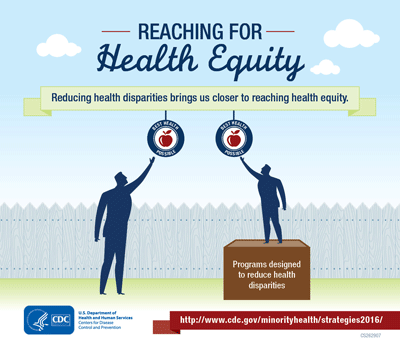Reaching for Health Equity
 Reducing health disparities brings us closer to reaching health equity. Learn about health equity and what CDC is doing to reduce health disparities.
Reducing health disparities brings us closer to reaching health equity. Learn about health equity and what CDC is doing to reduce health disparities.
What is Health Equity?
Health equity is when everyone has the opportunity to be as healthy as possible.
What Are Health Disparities?
Health disparities are differences in health outcomes and their causes among groups of people. For example, African American children are more likely to die from asthma compared to non-Hispanic White children. Reducing health disparities creates better health for all Americans.
Why is Health Equity Important?
Health is central to human happiness and well-being and is affected by where people live, learn, work, and play. According to the World Health Organization, health also makes an important contribution to economic progress.

What are some things that CDC is Doing?
Some CDC-sponsored programs aim to improve the health of groups or populations affected by health disparities:
- A report on the Traditional Foods Project,
- A description of Boston Children’s Hospital’s Community Asthma Initiative,
- A report on evidence-based interventions to improve levels of screening for colorectal cancer,
- A report documenting the reduction of disparities in hepatitis A virus (HAV) infection,
- Two reports outlining HIV prevention interventions,
- A report describing three community-level interventions linked to reductions in youth violence, and
- An evaluation of the Living Well with a Disability program.
Learn more about these programs in the Morbidity and Mortality Weekly Report Supplement, Strategies for Reducing Health Disparities—Selected CDC-Sponsored Interventions, United States, 2016.
- Page last reviewed: February 29, 2016
- Page last updated: February 29, 2016
- Content source:
- Office of Minority Health & Health Equity (OMHHE)
- Page maintained by: Office of the Associate Director for Communication, Digital Media Branch, Division of Public Affairs




 ShareCompartir
ShareCompartir